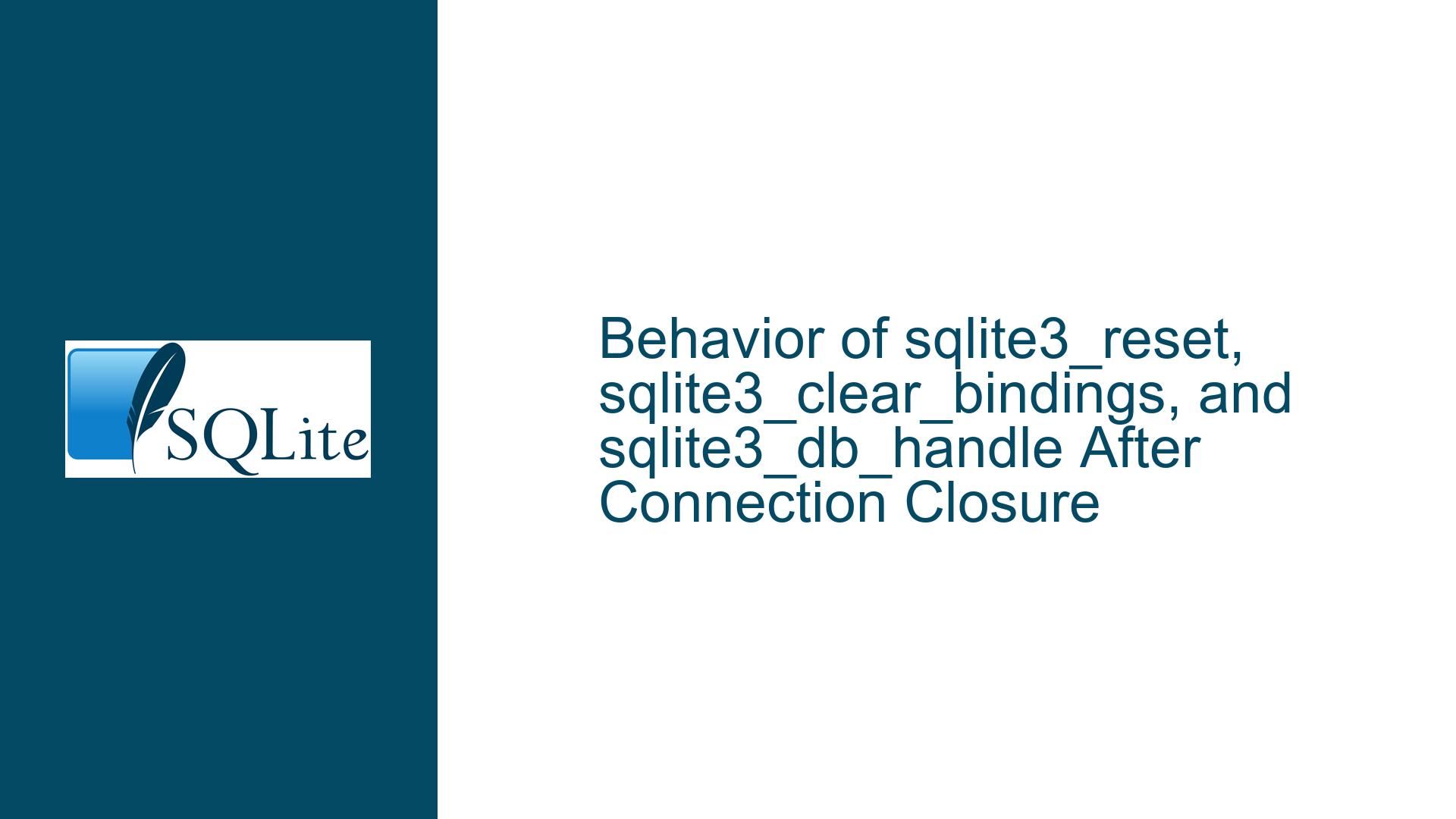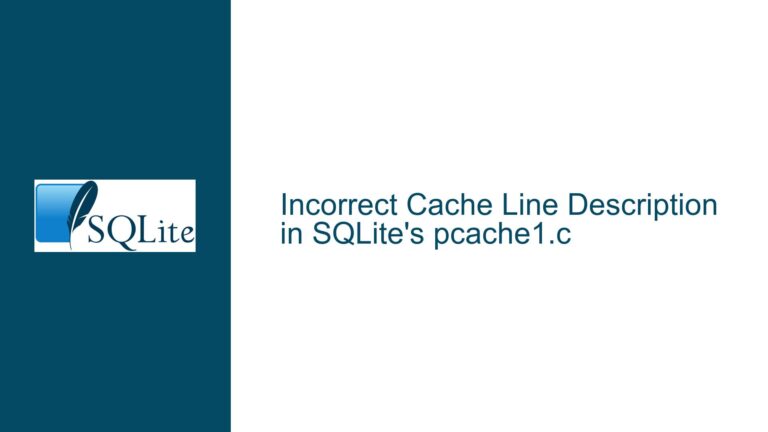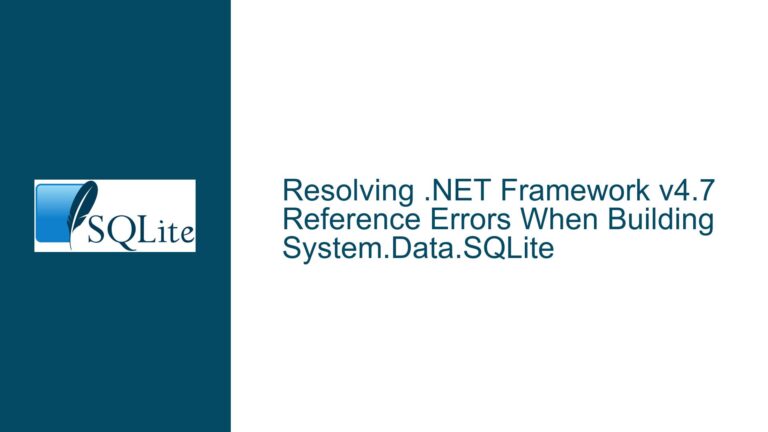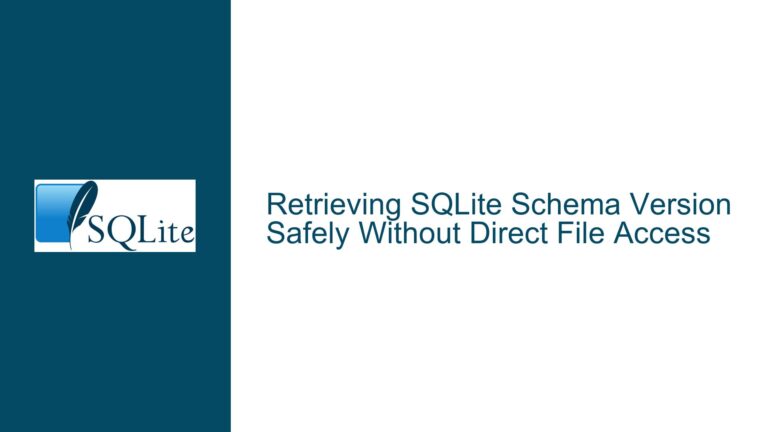Behavior of sqlite3_reset, sqlite3_clear_bindings, and sqlite3_db_handle After Connection Closure
Understanding Post-Closure Function Behavior in SQLite’s C/C++ Interface
The interaction between SQLite’s connection lifecycle and prepared statement operations raises critical questions about undefined states, memory safety, and API guarantees. When a database connection is closed using sqlite3_close_v2, the documentation explicitly allows finalizing prepared statements after closure. However, ambiguity arises when other statement-related functions—sqlite3_reset, sqlite3_clear_bindings, and sqlite3_db_handle—are called after the connection is closed. This guide dissects the risks, technical underpinnings, and mitigation strategies for these scenarios.
1. Post-Closure Function Invocation: Risks and Ambiguities
SQLite’s C/C++ API operates on two primary objects: database connections (managed via sqlite3 handles) and prepared statements (managed via sqlite3_stmt handles). The lifecycle of these objects is tightly coupled but not strictly hierarchical. While statements are derived from a connection, their validity depends on the connection’s state and the application’s resource management.
Key Ambiguities
- Undefined Behavior in API Contracts: The SQLite documentation does not explicitly define the behavior of
sqlite3_reset,sqlite3_clear_bindings, orsqlite3_db_handlewhen invoked after the parent connection is closed. This creates uncertainty about memory safety, error codes, and handle validity. - Dangling Handles and Memory Access: A closed connection may deallocate internal resources, leaving prepared statement handles pointing to invalid memory. Calling functions on these handles risks segmentation faults or heap corruption.
- Asynchronous Resource Management:
sqlite3_close_v2defers connection closure until all statements are finalized. However, if statements are not explicitly finalized, the connection remains open indefinitely, complicating post-closure function behavior.
Critical Dependencies
- Statement-Connection Binding: A prepared statement (
sqlite3_stmt) is intrinsically tied to its parentsqlite3connection. Functions likesqlite3_db_handleretrieve this connection, but its closure invalidates the statement’s operational context. - Finalization Order: While
sqlite3_finalizeis required to release a statement’s resources, the API permits finalizing statements after closing the connection. This flexibility introduces risks if other functions are called in the interim.
2. Root Causes of Undefined Post-Closure Behavior
Connection Closure Mechanics
When sqlite3_close_v2 is called, SQLite internally marks the connection for closure but defers actual resource deallocation until all associated statements are finalized. This deferred closure mechanism allows statements to outlive their parent connection, but it does not guarantee their safety.
- Deferred Closure Pitfalls: If a statement is not finalized, the connection remains open, creating a false sense of validity. Subsequent function calls on the statement may succeed but operate on an unstable connection.
- Implicit Finalization: In some configurations, closing a connection with unfinalized statements triggers automatic finalization. This varies by compile-time options and can lead to inconsistent behavior across environments.
Function-Specific Hazards
sqlite3_reset:- Resets a prepared statement to its initial state, allowing reuse.
- Post-Closure Risk: If the connection is closed, resetting the statement may attempt to access connection-specific resources (e.g., schema data, transaction states), leading to undefined behavior.
sqlite3_clear_bindings:- Clears bound parameter values from a statement.
- Post-Closure Risk: Binding data is managed within the statement’s memory. However, if the connection’s error state or memory context is invalid, clearing bindings may corrupt heap metadata.
sqlite3_db_handle:- Retrieves the
sqlite3handle associated with a statement. - Post-Closure Risk: Returns a pointer to the original connection, even if closed. Dereferencing this handle in other functions (e.g.,
sqlite3_exec) risks use-after-free errors.
- Retrieves the
Memory Management Nuances
- Ownership Boundaries: SQLite’s API does not enforce ownership rules between connections and statements. Developers must manually ensure that statements are finalized before or after connections, but misordering can leave dangling pointers.
- Error Code Ambiguity: Functions called on invalid handles may return generic error codes (e.g.,
SQLITE_MISUSE), but this is not guaranteed. Silent failures or memory corruption are possible.
3. Mitigation Strategies and Best Practices
Preemptive Resource Management
Explicit Finalization Order:
- Always finalize prepared statements using
sqlite3_finalizebefore closing the connection. This eliminates ambiguity and ensures the connection’s resources are freed immediately. - Example workflow:
sqlite3_stmt *stmt; sqlite3_prepare_v2(db, "SELECT * FROM tbl", -1, &stmt, NULL); // Execute and process results sqlite3_finalize(stmt); // Finalize before closing sqlite3_close_v2(db);
- Always finalize prepared statements using
Connection Closure Validation:
- Check the return value of
sqlite3_close_v2. If it returnsSQLITE_BUSY, outstanding statements exist, and the connection remains open. Usesqlite3_next_stmtto identify and finalize remaining statements.
- Check the return value of
Post-Closure Function Safety
Avoid All Post-Closure Calls:
- Treat all statement functions as invalid after closing the connection. Even if
sqlite3_db_handlereturns a non-NULL pointer, dereferencing it is unsafe.
- Treat all statement functions as invalid after closing the connection. Even if
Nullify Handles Programmatically:
- After finalizing statements or closing connections, set handles to
NULLto prevent accidental reuse:sqlite3_finalize(stmt); stmt = NULL; // Prevent reuse sqlite3_close_v2(db); db = NULL;
- After finalizing statements or closing connections, set handles to
Leverage Static Analysis Tools:
- Use tools like Clang’s AddressSanitizer or Valgrind to detect use-after-free and invalid pointer access when experimenting with post-closure function calls.
Error Handling and Diagnostics
Defensive Error Checking:
- After calling any statement function, check the return code. If
SQLITE_MISUSEorSQLITE_ERRORis returned, assume the statement or connection is invalid.
- After calling any statement function, check the return code. If
Connection Lifetime Logging:
- Instrument code with logging to track connection and statement lifecycles. Log entries should include handle addresses and function invocations to diagnose use-after-close scenarios.
API Contract Adherence
Documentation-Driven Development:
- Treat undocumented behaviors as undefined. For example, SQLite’s documentation states that
sqlite3_close_v2allows finalization after closure but does not extend this guarantee tosqlite3_resetorsqlite3_clear_bindings.
- Treat undocumented behaviors as undefined. For example, SQLite’s documentation states that
Cross-Version Testing:
- Test code across SQLite versions (3.36+, 3.40+, etc.), as post-closure behavior may change subtly. For instance, SQLite 3.44.0 introduced stricter handle validation in debug builds.
Advanced Techniques
Wrapper Libraries:
- Use object-oriented wrappers (e.g., C++ RAII classes) to enforce lifetime management:
class SQLiteStatement { sqlite3_stmt *stmt_; public: SQLiteStatement(sqlite3 *db, const char *sql) { sqlite3_prepare_v2(db, sql, -1, &stmt_, nullptr); } ~SQLiteStatement() { if (stmt_) sqlite3_finalize(stmt_); } // Disallow copying; use move semantics };
- Use object-oriented wrappers (e.g., C++ RAII classes) to enforce lifetime management:
Connection Pooling:
- Maintain a pool of open connections to avoid frequent open/close cycles. This reduces the risk of mismanaging statement lifetimes across short-lived connections.
By adhering to strict resource management protocols and treating post-closure function calls as inherently unsafe, developers can mitigate risks associated with undefined SQLite behaviors. Proactive instrumentation and modern tooling further safeguard against memory corruption and logical errors.






